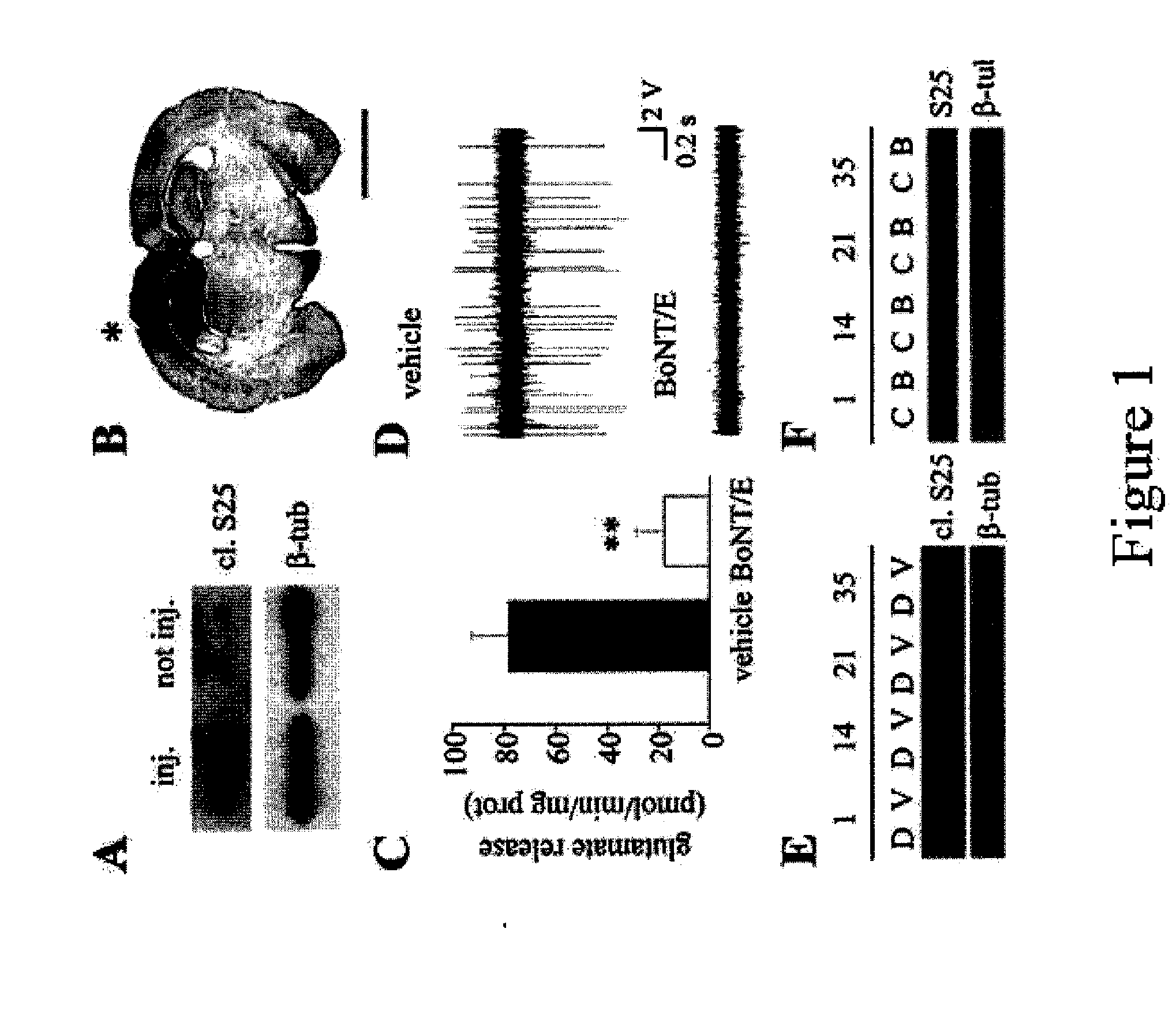Method for the Mapping of the Epileptogenic Focus in the Pre-Surgical Evaluation of Patients with Intractable Epilepsy
a technology of epileptogenic focus and presurgical evaluation, which is applied in the field of mapping the epileptogenic focus in the presurgical evaluation, can solve the problems of difficulty in accurately difficulty in identifying the epileptogenic zone, and ineffective curing of the disease of one third of epilepsy surgery interventions, so as to improve the rate of successful surgery, improve the accuracy of selection, and improve the effect of patient selection
- Summary
- Abstract
- Description
- Claims
- Application Information
AI Technical Summary
Benefits of technology
Problems solved by technology
Method used
Image
Examples
example 1
Characterization of BoNT / E Actions in the Hippocampus
BoNT / E Injections
[0087] BoNT / E was obtained by WAKO (Japan), trypsin activated, purified and tested as described in Schiavo and Montecucco (Schiavo G., Montecucco C. (1995) Methods Enzymol 248:643-652). Its potency was evaluated with the mice phrenic nerve-hemidiaphragm test. Two unilateral stereotaxic infusions of 1.5 μl of BoNT / E (50 nM) or vehicle (2% rat serum albumin in PBS) were made into the dorsal hippocampus under avertin anaesthesia at postnatal day (P) 35. P35 rats were chosen since they display a maximal sensitivity to KA-induced seizures (Ben-Ari Y (1985) Neuroscience 14:375-403; Stafstrom et al. (1993) Epilepsia 34:420-432). Coordinates in mm from bregma were (nose bar −2.5): for CA1, AP −2.4, L+1.8, H 2.1 below dura; for CA3, AP −2.4, L+3.3, H 3 below dura.
Detection of Cleaved SNAP-25
[0088] Cleaved SNAP-25 was detected by immunostaining and immunoblotting using a peptide-affinity purified polyclonal antibody r...
example 2
EEG (Electroencephalographic) Analysis after Intrahippocampal KA
[0095] Rats were unilaterally infused into the left dorsal hippocampus with BoNT / E (n=8) or vehicle (n=8) as described above under avertin anaesthesia. At the end of the infusion procedure, one screw electrode was placed over the parietal cortex ipsilateral to the injected hippocampus together with a ground lead over the nasal sinus. Two depth bipolar electrodes made of insulated nichrome wire (60 μm) were implanted bilaterally into the dorsal hippocampus (nose bar −2.5; mm from bregma, AP, −2.4; L+1.8; H 3.0 below dura) and a guide cannula was glued to the left side depth electrode and positioned on top of dura for the intrahippocampal injection of KA. Surface and depth electrodes were connected to a multipin socket and secured to the skull together with the injection cannula by acrylic dental cement. Two days after surgery, freely-moving rats injected with BoNT / E or its vehicle received a unilateral injection of 40 n...
example 3
Behavioral Analysis after Systemic KA
[0101] Behavioral, but not EEG analysis of seizures, was carried out in rats systemically injected with KA.
[0102] Thirty rats received hippocampal injections of BoNT / E at P35. Control animals of the same age (n=39) were injected with vehicle. One day after the injections, animals received a convulsive dose (8 mg / kg, i.p) of KA (Ocean Produce International, Shelburne, NS, Canada). Naïve animals which only received KA at P36 (n=20) were also used.
[0103] Rats were observed by an investigator unaware of the treatment. For each animal, behavior was scored every 5 minutes for a period of 4 hours after KA administration, according to a previously defined seizure rating scale (Schauwecker, P E and Steward, O (1997) Proc Natl Acad Sci USA 94:4103-4108; Bozzi et al. (2000) J Neurosci 20:8643-8649): stage 0: normal behavior; stage 1: immobility; stage 2: stereotypes; stage 3: wet dog shakes, head bobbing; stage 4: sporadic clonus of forelimbs with rearin...
PUM
| Property | Measurement | Unit |
|---|---|---|
| Time | aaaaa | aaaaa |
| Time | aaaaa | aaaaa |
| Volume | aaaaa | aaaaa |
Abstract
Description
Claims
Application Information
 Login to View More
Login to View More - R&D
- Intellectual Property
- Life Sciences
- Materials
- Tech Scout
- Unparalleled Data Quality
- Higher Quality Content
- 60% Fewer Hallucinations
Browse by: Latest US Patents, China's latest patents, Technical Efficacy Thesaurus, Application Domain, Technology Topic, Popular Technical Reports.
© 2025 PatSnap. All rights reserved.Legal|Privacy policy|Modern Slavery Act Transparency Statement|Sitemap|About US| Contact US: help@patsnap.com



